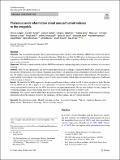Thalamus sends information about arousal but not valence to the amygdala
Author(s)
Leppla, Chris A.; Keyes, Laurel R.; Glober, Gordon; Matthews, Gillian A.; Batra, Kanha; Jay, Maya; Feng, Yu; Chen, Hannah S.; Mills, Fergil; Delahanty, Jeremy; Olson, Jacob M.; Nieh, Edward H.; ... Show more Show less
Download213_2022_Article_6284.pdf (3.315Mb)
Publisher with Creative Commons License
Publisher with Creative Commons License
Creative Commons Attribution
Terms of use
Metadata
Show full item recordAbstract
Abstract
Rationale
The basolateral amygdala (BLA) and medial geniculate nucleus of the thalamus (MGN) have both been shown to be necessary for the formation of associative learning. While the role that the BLA plays in this process has long been emphasized, the MGN has been less well-studied and surrounded by debate regarding whether the relay of sensory information is active or passive.
Objectives
We seek to understand the role the MGN has within the thalamoamgydala circuit in the formation of associative learning.
Methods
Here, we use optogenetics and in vivo electrophysiological recordings to dissect the MGN-BLA circuit and explore the specific subpopulations for evidence of learning and synthesis of information that could impact downstream BLA encoding. We employ various machine learning techniques to investigate function within neural subpopulations. We introduce a novel method to investigate tonic changes across trial-by-trial structure, which offers an alternative approach to traditional trial-averaging techniques.
Results
We find that the MGN appears to encode arousal but not valence, unlike the BLA which encodes for both. We find that the MGN and the BLA appear to react differently to expected and unexpected outcomes; the BLA biased responses toward reward prediction error and the MGN focused on anticipated punishment. We uncover evidence of tonic changes by visualizing changes across trials during inter-trial intervals (baseline epochs) for a subset of cells.
Conclusion
We conclude that the MGN-BLA projector population acts as both filter and transferer of information by relaying information about the salience of cues to the amygdala, but these signals are not valence-specified.
Date issued
2022-12-16Department
Picower Institute for Learning and Memory; Massachusetts Institute of Technology. Department of Brain and Cognitive SciencesPublisher
Springer Berlin Heidelberg
Citation
Leppla, Chris A., Keyes, Laurel R., Glober, Gordon, Matthews, Gillian A., Batra, Kanha et al. 2022. "Thalamus sends information about arousal but not valence to the amygdala."
Version: Final published version